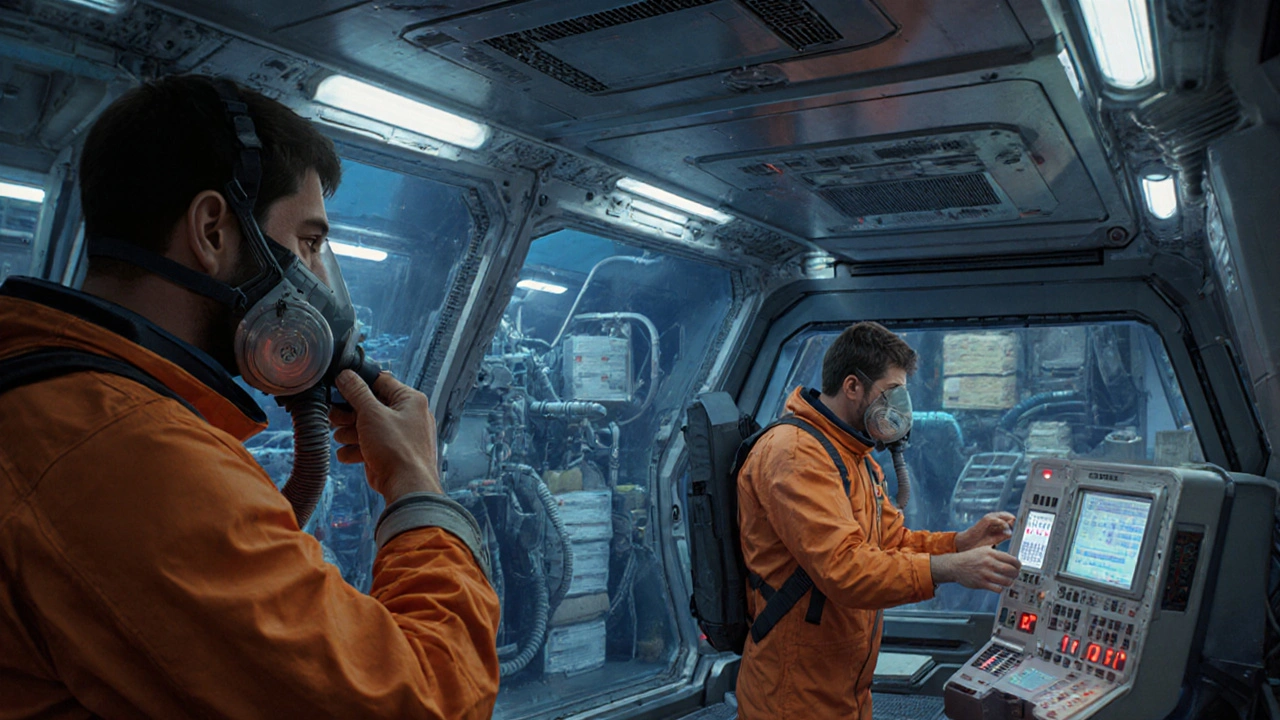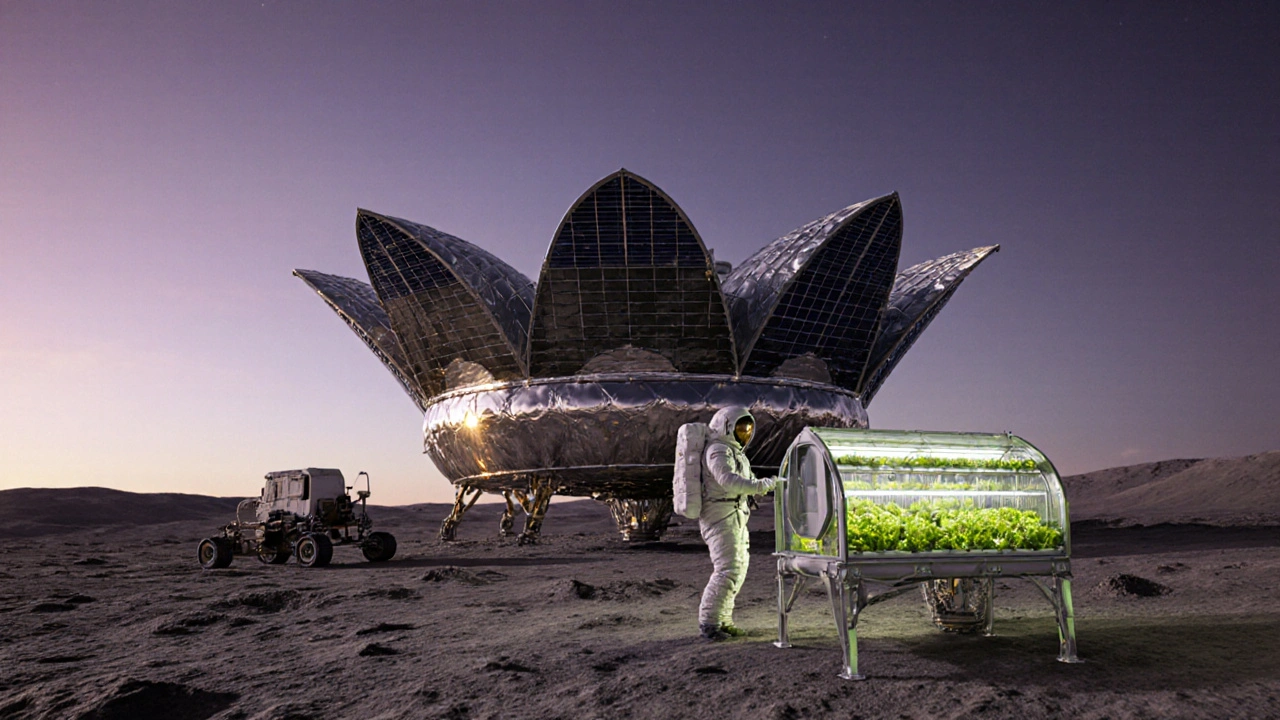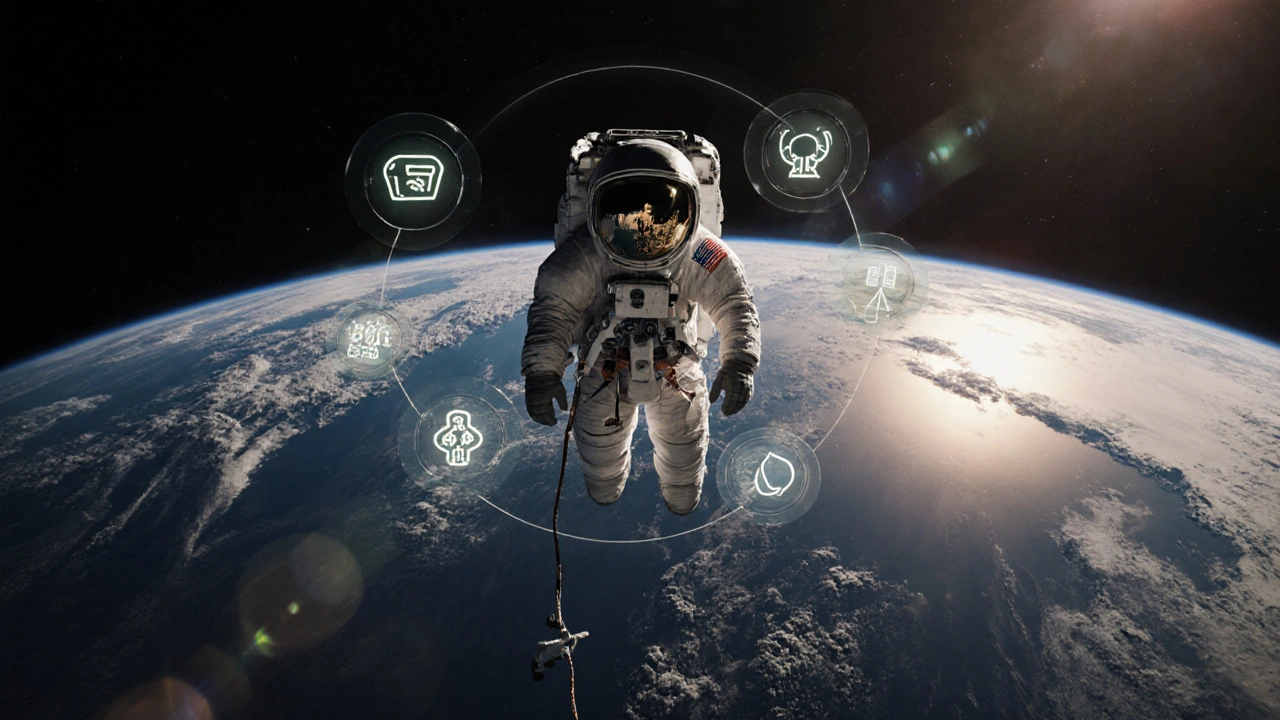Space Mission Survival Calculator
Mission Parameters
Enter values based on your hypothetical space mission.
Results
Enter values and click calculate to see survival estimates.
When you picture an astronaut floating above Earth, the image that sticks in most people’s heads is a sleek suit and a high‑tech spacecraft. But beneath the glossy visuals lies a stark reality: staying alive in space boils down to five non‑negotiable needs. If any one of them fails, the mission ends in disaster. Below we break down each requirement, explain how engineers meet it, and show what happens when the system falters.
Key Takeaways
- Oxygen, food, water, power/temperature control, and a pressurized habitat are the five core survival pillars.
- Each pillar is backed by redundant, continuously monitored life‑support subsystems.
- Failure modes are understood, and crew members train for emergency procedures.
- Modern missions use closed‑loop recycling to cut down resupply needs, especially for water and air.
- Future habitats on the Moon or Mars will expand these basics while adding radiation shielding and in‑situ resource utilization.
Understanding these basics is crucial for anyone following space exploration, whether you’re a student, a hobbyist, or a future crew‑member.
1. Oxygen - The Breath of Life
Oxygen is the vital gas that fuels human metabolism and keeps blood oxygenated. In space, it can’t be taken for granted; the thin vacuum pulls it right out of your lungs. Modern spacecraft rely on two complementary methods: electro‑chemical oxygen generators (the “O2‑gen” units) and high‑pressure tanks. The former split water molecules into hydrogen and oxygen using electricity, a process called electrolysis. The International Space Station (ISS) runs several of these units continuously, producing roughly 1.5kg of O₂ per day-enough for three crew members.
Redundancy is baked in. If an electrolyzer fails, backup tanks provide minutes to hours of breathable air, and the crew can switch to backup units. Sensors constantly monitor partial pressure, temperature, and humidity; alarms trigger if O₂ drops below 19.5% or spikes above 23.5% (the safe range for humans).
In an emergency, astronauts can don personal oxygen masks connected to a supply canister, similar to emergency oxygen sets on commercial aircraft. Training includes rapid donning drills, because a dropped O₂ level can lead to hypoxia within seconds.
2. Food - Fuel for the Body and Mind
Food is the source of calories, vitamins, and minerals required for energy and physiological health. Space meals have evolved from gelatin‑based cubes to thermostabilized entrees, freeze‑dried fruits, and even 3‑D‑printed nutrition bars. The key challenges are weight, volume, and shelf‑life. Each kilogram of food costs thousands of dollars to launch, so menus are carefully balanced for caloric density and micronutrient completeness.
On the ISS, each astronaut consumes about 0.8kg of food per day, split among breakfast, lunch, and dinner. The food system incorporates a “closed‑loop” approach: waste packaging is minimized, and some foods are pre‑processed to retain antioxidants that degrade in microgravity. In case of a supply shortage, the crew can stretch rations, focusing on high‑energy items such as nuts and protein bars.
Meal planning also considers psychological well‑being. Familiar flavors and occasional treats (like pizza or chocolate) boost morale on long missions. Astronauts practice cooking in microgravity using a special hot‑water dispenser that rehydrates freeze‑dried meals without spilling.

3. Water - The Universal Solvent
Water is the essential fluid for drinking, hygiene, and many life‑support reactions such as electrolysis. It’s the most massive consumable on any mission. The ISS recycles up to 93% of water from urine, sweat, and cabin humidity using a series of filters, catalytic reactors, and distillation units. This closed‑loop system slashes the need for launch‑mass resupply.
Each crew member needs roughly 3L of potable water per day, plus additional for hygiene. If the recycling system fails, emergency water tanks provide a limited reserve-typically enough for a few days, enough time to repair or replace the faulty module.
Microgravity makes fluid handling tricky. Water doesn’t flow as a stream; it forms floating blobs. To drink, astronauts use sealed pouches with straws that have a one‑way valve, preventing bubbles from escaping and causing fogging in the cabin.
4. Power & Temperature Control - Keeping the Ship Running
Power is the energy that runs life‑support equipment, communications, and thermal regulators. Solar arrays are the primary source for low‑Earth orbit stations, converting sunlight into electricity that charges batteries for eclipse periods. On deep‑space probes, radioisotope thermoelectric generators (RTGs) provide steady power, but crewed ships still rely on solar or fuel‑cell systems.
Power isn’t just about keeping lights on; it drives the O₂ generators, water recycler, and heating/cooling loops. The habitat temperature must stay within a narrow band-about 22°C (72°F)-to prevent equipment overheating or crew hypothermia. Heat exchangers, fluid loops, and radiators dissipate excess heat into space, while electric heaters kick in when the cabin gets too cold.
Redundant power buses and backup batteries safeguard against solar array failures. If a panel loses orientation, the crew can manually adjust it using robotic arms, a procedure practiced repeatedly during training.
5. Habitat & Pressure - The Safe Enclosure
Habitat is the pressurized module that protects astronauts from vacuum, temperature extremes, and radiation. It maintains an internal pressure of about 101kPa (14.7psi), similar to Earth sea‑level. The structural shell, usually aluminum alloy or composite material, resists micrometeoroid impacts with multi‑layer shielding.
In addition to structural integrity, the habitat includes an environmental control and life‑support system (ECLSS) that monitors gas composition, humidity, and contaminant levels. If a leak is detected, automatic isolation valves seal off the affected section while crews don personal protective equipment and repair the breach.
Future lunar or Martian habitats will need extra layers, namely radiation shielding made from regolith or water, because the thin atmospheres of those bodies provide little protection. For now, Earth‑orbiting stations rely on Earth's magnetic field to deflect most solar particle events, but solar storms can still raise radiation levels, prompting crew to retreat to the most shielded part of the module.
Quick Reference Table
| Need | Primary Source | Daily Requirement (per crew) | Key Redundancy |
|---|---|---|---|
| Oxygen | Electrolysis of water, high‑pressure tanks | ~1.5kg | Backup tanks, secondary electrolyzer |
| Food | Thermostabilized meals, freeze‑dried packs | ~0.8kg | Emergency ration packs |
| Water | Closed‑loop recycling, launch tanks | ~3L (drinking) + hygiene | Reserve tanks, manual purification kit |
| Power & Temp. | Solar arrays, batteries | ~8-10kW total load | Redundant power buses, backup batteries |
| Habitat/Pressure | Pressurized module, ECLSS | 101kPa, 22°C | Isolation valves, emergency patches |

Beyond the Basics - Supporting Systems
While the five pillars keep you breathing, eating, drinking, warm, and safe, two extra systems often tip the balance between mission success and failure.
Communication is the link that lets astronauts stay in contact with ground control and receive critical updates. Antennas, transceivers, and relay satellites form a network that provides voice, video, and data streams. A loss of communications can turn a minor issue into a crisis because the crew can’t get expert guidance. Redundant radios in different frequency bands (S‑band, Ku‑band) are standard.
Radiation Shielding is the protective barrier that reduces exposure to cosmic rays and solar particle events. In low Earth orbit, Earth’s magnetosphere does most of the work, but solar flares can spike doses. The ISS has a “storm shelter” - a heavily shielded module where crew can take refuge for a few hours. Deep‑space missions will rely on water or hydrogen‑rich materials as the primary shield.
What Happens If One Pillar Fails?
Spacecraft designers assume that failures happen; they just hope they’re rare. Here’s a quick look at the typical response chain for each pillar:
- Oxygen loss: Alarms sound, crew switches to backup tanks, isolates the faulty electrolyzer, and initiates an emergency oxygen supply from the rescue module.
- Food shortage: Crew rationing begins, high‑calorie emergency bars are consumed first, and mission control schedules an early resupply if possible.
- Water contamination: The filtration system flags abnormal conductivity, crew activates the backup purification kit, and uses reserve tanks while repairs are made.
- Power outage: Batteries sustain critical systems for up to 30minutes; solar arrays are manually re‑oriented; if the outage persists, non‑essential equipment is shut down.
- Habitat breach: Isolation valves close, crew dons personal O₂ masks, the leak is patched using epoxy‑based sealant, and the cabin is repressurized.
Training covers each scenario in depth. Astronauts practice emergency drills every few weeks, ensuring muscle memory and decision‑making speed are honed.
Future Outlook - Growing the Survival Toolbox
As humanity eyes Moon bases and Mars habitats, the five core needs stay the same, but the solutions expand. In‑situ resource utilization (ISRU) will let crews extract water from lunar regolith, produce oxygen via MOXIE‑type devices, and grow food in hydroponic modules. Power will shift from solar‑only to hybrid systems that include small nuclear reactors. Radiation shielding will become an integral part of habitat construction, using locally sourced materials instead of hauling massive shields from Earth.
These advances will make long‑duration missions feasible, but the underlying principle remains: astronaut survival depends first and foremost on providing reliable oxygen, food, water, power, and a safe pressurized environment.
Frequently Asked Questions
How long can a spacecraft survive without a power source?
Most crewed vehicles carry enough battery capacity to keep life‑support, communications, and thermal control running for 30‑45 minutes after a total power loss. During that window the crew can troubleshoot, switch to backup generators, or, in worst‑case, use emergency hand‑crank generators if available.
What is the biggest source of water loss on the ISS?
Leakage through seals and minor condensation that isn’t fully captured by the humidity condensers account for most losses. The recycling system recovers about 93% of used water, meaning roughly 7% still needs to be replenished from Earth.
Can astronauts eat fresh food in space?
Yes, but only on short‑duration missions or in orbital labs that have a small greenhouse. Fresh lettuce, radishes, and herbs have been grown on the ISS, providing vitamin C and a morale boost. For long‑term missions, most food will still be pre‑processed.
What happens if the habitat pressure drops suddenly?
Cabin pressure alarms trigger instantly. Isolation valves seal off the affected module, crew members put on emergency O₂ masks, and the crew uses the onboard repair kit to patch the breach. The ECLSS then repressurizes the compartment over a few minutes.
How do spacecraft protect against solar radiation spikes?
Mission control monitors solar activity in real time. When a coronal mass ejection is forecasted, crews move to the most shielded part of the station (the “storm shelter”). Additional shielding, such as water walls or polyethylene panels, absorbs high‑energy particles.


12 Responses
The article barely scratches the surface; anyone who thinks these five items are trivial clearly lacks real engineering insight.
i cant believe u think thats enough the O2 gen is more complex than u think lol
Space travel is a wild adventure that blends science and human spirit.
When you step into a habitat, the first thing that greets you is the hum of life‑support systems working tirelessly.
Oxygen generation, like a quiet miracle, splits water molecules to keep the cabin breathable.
Food, though it looks like tiny packets, packs a punch of calories and morale‑boosting flavors.
Water, the universal solvent, circles through filters, reclaiming every drop from sweat and breath.
Power flows from solar panels, turning sunlight into the electricity that keeps everything alive.
Temperature control acts like an invisible thermostat, preventing the cabin from becoming an icebox or a sauna.
The pressurized habitat itself is a bubble of safety, shielding you from the vacuum and radiation outside.
Each of these pillars has built‑in redundancy, because engineers know that failure is not an option.
If an oxygen generator sputters, backup tanks burst into action within seconds.
If food supplies run low, crews ration high‑energy bars while waiting for the next resupply.
A water leak triggers alarms, sealing valves, and a quick patch using epoxy‑based sealant.
Power outages are met with batteries that hold the lights on long enough to reboot the arrays.
Thermal spikes are softened by radiators that dump excess heat into the void.
Habitat breaches are sealed with emergency patches, and the cabin is repressurized in minutes.
All together, these systems turn a cold metal box into a home where humans can live, work, and dream beyond Earth.
great summary love how you broke each system down nicely
Honestly, this stuff is boring as hell.
Hey, don’t let the hype get you down 😊 you’re still learning and that’s awesome 🚀
What most people don’t see is that the agencies keep the real resource limits hidden, feeding us just enough data to stay in control.
Well, as an American we know our engineers built the best life‑support tech and no foreign entity could ever match it.
While your point is valid, it would be more accurate to state that “oxygen generation” rather than “O2 generation,” and to avoid colloquial abbreviations.
Sure, but that “accurate” phrasing is just the elite’s way of masking their true agenda, don’t you think
Honestly this article is a mixed bag; while it covers the basics adequately, the depth is lacking and the presentation feels half‑hearted, which is unacceptable for serious readers.
I appreciate your honesty and would love to see a deeper dive into the recycling processes, especially how they handle unexpected contaminants.